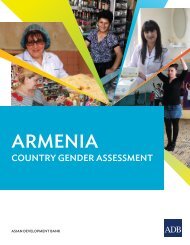Civic Activism as a Novel Component of Armenian Civil Society
English-3
English-3
Create successful ePaper yourself
Turn your PDF publications into a flip-book with our unique Google optimized e-Paper software.
2.1. The NGO Sector<br />
The NGO sector in contemporary <strong>Armenian</strong> civil society can be characterised <strong>as</strong> fairly<br />
institutionalised but detached from the broader public. The first part (institutionalisation) is a<br />
comparatively new development, while the second part (detachment from the public) h<strong>as</strong><br />
plagued <strong>Armenian</strong> civil society for almost two decades. This is a typical “weakness” <strong>of</strong> a postcommunist<br />
<strong>as</strong>sociational political culture (Howard 2003) that remains unchanged in Armenia.<br />
Focusing on the NGOs <strong>as</strong> main actors <strong>of</strong> civil society, our previous research shows that in<br />
addition to many new NGOs being established in Armenia every year a substantial number <strong>of</strong><br />
NGOs have accumulated a track record <strong>of</strong> activities and achieved a re<strong>as</strong>onable level <strong>of</strong> financial<br />
and organisational viability. For instance, if ten years ago NGOs were characterised <strong>as</strong> mostly<br />
dependent on a ‘strong leader’, who w<strong>as</strong> usually the founder, with only a few NGOs<br />
experiencing a leadership transition (Blue, Payton, and Kharatyan 2001), a recent organisational<br />
survey conducted by TCPA shows that 75% <strong>of</strong> NGOs surveyed have undergone at le<strong>as</strong>t one<br />
change in leadership. A number <strong>of</strong> other variables (such <strong>as</strong> internal NGO governing structures,<br />
number <strong>of</strong> staff and volunteers, fundraising activities, and public outreach) suggest that the NGO<br />
sector is much more institutionalised and stable than w<strong>as</strong> the c<strong>as</strong>e twenty or even ten years ago.<br />
Thus, in terms <strong>of</strong> organisational structures, there clearly is development <strong>of</strong> civil society<br />
(Paturyan and Gevorgyan 2014b).<br />
However, if these organisations are considered in the broader context <strong>of</strong> public<br />
engagement, the picture is discouraging. Public trust in NGOs is low (Paturyan and Gevorgyan<br />
2014a) and decre<strong>as</strong>ing: according to Cauc<strong>as</strong>us Barometer, the percentage <strong>of</strong> those who trust<br />
NGOs h<strong>as</strong> remained almost unchanged (from 19% in 2012 to 18% in 2013, which is a change<br />
within the margin <strong>of</strong> error), but the percentage <strong>of</strong> those who distrust NGOs incre<strong>as</strong>ed from 28%<br />
in 2012 to 36% in 2013. In terms <strong>of</strong> membership, <strong>Armenian</strong> civil society still suffers heavily<br />
from the post-communist dislike <strong>of</strong> formal <strong>as</strong>sociational life. The most recent World Values<br />
Survey data (2011 for Armenia) indicate negligibly low membership in various voluntary<br />
<strong>as</strong>sociations; such membership h<strong>as</strong> actually declined since 1997, when the previous WVS w<strong>as</strong><br />
conducted in Armenia. Thus, in terms <strong>of</strong> public attitudes and involvement, there is a striking lack<br />
<strong>of</strong> development, and one could even speak <strong>of</strong> a slight regression in the most recent years.<br />
In addition to public mistrust and disengagement, the <strong>Armenian</strong> NGO sector faces a set<br />
<strong>of</strong> problems caused by the rapid, donor-driven initial development <strong>of</strong> NGOs after the<br />
disintegration <strong>of</strong> the Soviet Union. The manifold challenges <strong>of</strong> regime transitions, accompanied<br />
by economic collapse, created the demand for social action, while generous international donor<br />
support boosted the supply. This process led to a mushrooming <strong>of</strong> NGOs heavily dependent on<br />
external donors. Ishkanian (2009) describes this process <strong>as</strong> “genetically engineered civil<br />
society.” While this influx <strong>of</strong> funds helped to establish a vibrant NGO sector, it created the set <strong>of</strong><br />
constraints that NGOs currently face. If international developmental aid were withdrawn, most<br />
NGOs would exhibit questionable organisational sustainability. More important, the legitimacy<br />
<strong>of</strong> civil society organisations to represent local voices is <strong>of</strong>ten disputed on the grounds that many<br />
NGOs are funded from abroad. Ishkanian (2009, 10) also argues that this overemph<strong>as</strong>is on NGOs<br />
16



